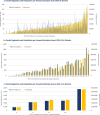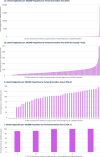Comparison of the distribution of the dental hygienist workforce and population in Ontario: a geospatial analysis
- PMID: 40375110
- PMCID: PMC12083121
- DOI: 10.1186/s12903-025-06092-1
Comparison of the distribution of the dental hygienist workforce and population in Ontario: a geospatial analysis
Abstract
Objectives: This study conducted a geospatial analysis of the distribution of the dental hygienist workforce relative to the distribution of the population in Ontario, Canada, aiming to address workforce imbalances and inform regional and international workforce planning.
Methods: Geospatial analysis techniques were employed to examine the dental hygienist workforce distribution using anonymized datasets from the College of Dental Hygienists of Ontario (the professional regulatory body) and the Canadian census. The data were linked using the forward sortation area (FSA) component of Canadian postal codes, covering 520 FSAs across Ontario. Analyses were conducted at three levels, based on different aggregations of postal code data.
Results: The study found significant variations in the distribution of dental hygienists across Ontario. The analysis revealed pockets of high dental hygienist density, mostly in urban areas, and areas with low dental hygienist rates, especially in rural and remote locations. The overall provincial rate was 97 dental hygienists per 100,000 population, with variation across the 520 FSAs, from zero to 20,000 dental hygienists per 100,000 population (or zero to 739 dental hygienists per 100,000 population if five outlier FSAs were removed).
Conclusions: The study underscores the complexity of dental hygienist workforce distribution in Ontario, revealing significant geographical disparities that suggest areas of both oversupply and undersupply. These insights provide actionable guidance for workforce policies and regulatory strategies, such as targeted incentives and public health initiatives, to address the mismatch between workforce supply and population needs. The findings highlight the importance of regular geospatial analyses to track changes in workforce distribution over time. The rigorous methodological approach and comprehensive evaluation of potential limitations offer valuable guidance for similar analyses in other jurisdictions. By providing a detailed framework and insights that extend beyond Ontario, this study contributes to the global understanding of dental hygienist workforce dynamics and supports the development of informed policies on a broader scale.
Keywords: Demand; Dental hygiene; Geospatial analysis; Supply; Workforce.
© 2025. The Author(s).
Conflict of interest statement
Declarations. Ethics approval and consent to participate: Not Applicable. The University of Toronto Research Ethics Board exempts research from human ethics review under certain situations, including when the research “…relies exclusively on information that is either of the following: (a) Publicly available through a mechanism set out by legislation or regulation and that is protected by law (e.g. Statistics Canada files), (b) In the public domain and the individuals to whom the information refers have no reasonable expectation of privacy (non-intrusive, does not involve direct interaction between the researcher and individuals through the Internet)” ( https://research.utoronto.ca/ethics-human-research/activities-exempt-human-ethics-review ). As our geospatial analysis relies on publicly available Statistics Canada census data and CDHO registrant data, this study did not require research ethics board approval. Consent for publication: Not applicable. Competing interests: Three co-authors (EB, KS, GP) are employed by the College of Dental Hygienists of Ontario which oversees the registration of dental hygienists in Ontario. The remaining author (MJD) has no conflicts of interest to declare.
Figures



Similar articles
-
Identification and assessment of factors that impact the demand for and supply of dental hygienists amidst an evolving workforce context: a scoping review.BMC Oral Health. 2024 May 29;24(1):631. doi: 10.1186/s12903-024-04392-6. BMC Oral Health. 2024. PMID: 38811920 Free PMC article.
-
Imbalances in the oral health workforce: a Canadian population-based study.BMC Health Serv Res. 2024 Oct 7;24(1):1191. doi: 10.1186/s12913-024-11677-7. BMC Health Serv Res. 2024. PMID: 39375673 Free PMC article.
-
Perception of Nepalese dental hygiene and dentistry students towards the dental hygienists profession.Int J Dent Hyg. 2017 Aug;15(3):219-228. doi: 10.1111/idh.12192. Epub 2016 Jan 12. Int J Dent Hyg. 2017. PMID: 26756212
-
Mapping the Quebec dental workforce: ranking rural oral health disparities.Rural Remote Health. 2016 Jan-Mar;16(1):3630. Epub 2016 Jan 27. Rural Remote Health. 2016. PMID: 26814190
-
Dental therapists/hygienists working in remote-rural primary care: a structured review of effectiveness, efficiency, sustainability, acceptability and affordability.Int Dent J. 2013 Apr;63(2):103-12. doi: 10.1111/idj.12025. Epub 2013 Mar 14. Int Dent J. 2013. PMID: 23550524 Free PMC article. Review.
References
-
- Dabaja I, Dinale D, Gulesserian L, Wright CF. ‘Work not as usual’: work and industrial relations in a post-COVID world. Labour Ind. 2023;33(1):1–10. 10.1080/10301763.2023.2174712https://www.tandfonline.com/action/showCitFormats?.
-
- Albreht T. Challenges to Global Health Emerging from the COVID-19 Pandemic. Sustainability. 2023;15(9):7633. 10.3390/su15097633.
-
- Boissay F, De Fiore F, Igan D, Pierres-Tejada A, Rees D. BIS Bulletin No 53: Are major advanced economies on the verge of a wage-price spiral? Bank Int Settlements; 2022. https://www.bis.org/publ/bisbull53.pdf.
-
- Bick A, Blandin A, Mertens K. Work from home before and after the COVID-19 Outbreak. Am Econ J Macroecon. 2023;15(4):1–39. 10.1257/mac.20210061.
-
- Barrero JM, Bloom N, Davis SJ. The evolution of work from home. National bureau of economic research working paper series. 2023. Working Paper 31686. https://www.nber.org/system/files/working_papers/w31686/w31686.pdf.
Publication types
MeSH terms
LinkOut - more resources
Full Text Sources

